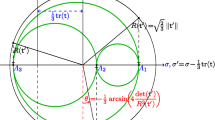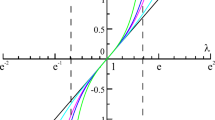Summary
Two yet undiscovered relations between the Eulerian logarithmic strain inV and two fundamental mechanical quantities, the stretching and the Cauchy stress, are disclosed. A new spin tensor and a new objective tensor-rate are accordingly introduced. Further, new rate-form constitutive models based on this objective tensor-rate are established. It is proved that
-
(i).
an objective corotational rate of the logarithmic strain inV can be exactly identical with the stretching and in all strain measures only inV enjoys this property, and
-
(ii).
InV and the Cauchy stress σ form a work-conjugate pair of strain and stress.
These properties of in ν are shown to determine a unique smooth spin tensor called logarithmic spin and by virtue of this spin a new tensor-rate called logarithmic rate is proposed. In all possible rate-form constitutive models relating the same kind of objective corotational rates of an Eulerian stress measure and an Eulerian strain measure, it is proved that the logarithmic rate is the only choice and the strain measure must be the logarithmic strain inV if the stretching, as is commonly assumed, is used to measure the rate of change of deformation. As an illustration, it is shown that all finite deformation responses of the grade-zero hypoelastic model based on the logarithmic rate are completely in agreement with those of a finite deformation elastic model and moreover this simplest rate-form constitutive model based on the logarithmic rate can predict the phenomenon of the known hypoelastic yield at simple shear.
Similar content being viewed by others
References
Aifantis, E. C.: The physics of plastic deformation. Int. J. Plasticity3, 211–247 (1987).
Carlson, D. E., Hoger, A.: The derivative of a tensor-valued function of a tensor. Q. Appl. Math.44, 409–423 (1986).
Dafalias, Y. F.: Corotational rates for kinematical hardening at large plastic deformations. J. Appl. Mech.50, 561–565 (1983).
Dafalias, Y. F.: The plastic spin. J. Appl. Mech.52, 865–871 (1985).
Dienes, J. K.: On the analysis of rotation and stress rate in deforming bodies. Acta Mech.32, 217–232 (1979).
Dienes, J. K.: A discussion of material rotation and stress rate. Acta Mech.65, 1–11 (1987).
Dubey, R. N.: Choice of tensor-rates — a methodology. SM Arch.12, 233–244 (1987).
Eringen, A. C.: Nonlinear theory of continuous media. New York: McGraw-Hill 1962.
Fitzgerald, J. E.: A tensorial Hencky measure of strain and strain for finite deformation. J. Appl. Phys.51, 5111–5115 (1980).
Guo, Z. H.: Recent investigation in strain and stress rates in nonlinear continuum mechanics. Appl. Math. Mech.4, 639–648 (1983).
Gurtin, M. E.: An introduction to continuum mechanics. New York: Academic Press 1981.
Gurtin, M. E., Spear, K.: On the relationship between the logarithmic strain rate and the stretching tensor. Int. J. Solids Struct.19, 437–444 (1983).
Haupt, P., Tsakmakis, C.: On the application of dual variables in continuum mechanics. Continuum Mech. Thermodyn.1, 165–196 (1989).
Heiduschke, K.: The logarithmic strain space description. Int. J. Solids Struct.32, 1047–1062 (1995).
Hencky, H.: Über die Form des Elastizitätsgesetzes bei ideal elastischen Stoffen. Z. Techn. Phys.9, 214–247 (1928).
Hill, R.: On constitutive inequalities for simple materials. J. Mech. Phys. Solids16, 229–242; 315–322 (1968).
Hill, R.: Constitutive inequalities for isotropic elastic solids under finite strain. Proc. R. Soc. London Ser. A326, 131–147 (1970).
Hill, R.: Aspects of invariance in solid mechanics. Adv. Appl. Mech.18, 1–75 (1978).
Hoger, A.: The material time derivative of logarithmic strain. Int. J. Solids Struct.22, 1019–1032 (1986).
Hoger, A.: The stress conjugate to logarithmic strain. Int. J. Solids Struct.23, 1645–1656 (1987).
Hutchinson, J., Neale, K.: Finite strainJ 2 deformation theory. In: Finite elasticity (Carlson, D. E., Shield, R. T., eds.), pp. 237–247. The Hague-Boston-London: Martinus Nijhoff 1980.
Lee, E. H., Mallet, R. L., Wertheimer, T. B.: Stress analysis for anisotropic hardening in finitedeformation plasticity. J. Appl. Mech.50, 554–560 (1983).
Lehmann, T.: Anisotrope plastische Formänderungen. Rom. J. Techn. Sci. Appl. Mech.17, 1077–1086 (1972).
Lehmann, T.: On the balance of energy and entropy at inelastic deformations of solid bodies. Eur. J. Mech. Solids8, 235–251 (1989).
Lehmann, T., Liang, H. Y.: The stress conjugate to logarithmic strain inV. ZAMM73, 357–363 (1993).
Macvean, D. B.: Die Elementararbeit in einem Kontinuum und die Zuordnung von Spannungs- und Verzerrungstensoren. ZAMP19, 157–186 (1968).
Man, C. S., Guo, Z. H.: A basis-free formula for time rate of Hill's strain tensors. Int. J. Solids Struct.30, 2819–2842 (1993).
Nagtegaal, J. C., de Jong, J. E.: Some aspects of non-isotropic work-hardening in finite strain plasticity. In. Proceedings of the workshop on plasticity of metals at finite strain: theory, experiment and computation, (Lee, E. H., Mallet, R. L., eds.), pp. 65–102. Stanford University 1982.
Neale, K. W.: Phenomenological constitutive laws in finite plasticity. SM Arch.6, 79–128 (1981).
Ogden, R. W.: Nonlinear elastic deformations. Chichester: Ellis Horwood 1984.
Rice, J. R.: Continuum mechanics and thermodynamics of plasticity in relation to microscale deformation mechanism. In: Constitutive equations in plasticity (Argon, A. S., ed.). Cambridge, Mass.: MIT Press 1975.
Richter, H.: Das isotrope Elastizitätsgesetz. ZAMM28, 205–209 (1948).
Stickforth, J., Wegener, K.: A note on Dienes' and Aifantis' corotational derivatives. Acta Mech.74, 227–234 (1988).
Stören, S., Rice, J. R.: Localized necking in thin sheets. J. Mech. Phys. Solids23, 421–441 (1975).
Truesdell, C.: Hypo-elastic shear. J. Appl. Phys.27, 441–447 (1956).
Truesdell, C., Noll, W.: The nonlinear field theories of mechanics. In: Handbuch der Physik, (Flügge, S., ed.), vol. III/3, pp. 441–447. Berlin: Springer 1965.
Xiao, H.: Unified explicit basis-free expressions for time rate and conjugate stress of an arbitrary Hill' strain. Int. J. Solids Struct.32, 3327–3340 (1995).
Xiao, H., Bruhns, O. T., Meyers, A.: On conjugate stresses of Lagrangean and Eulerian strain measures. (in preparation).
Xiao, H., Bruhns, O. T., Meyers, A.: Strain rates and material spins. J. Elasticity (in press).
Xia, Z., Ellyin, F.: A stress rate measure for finite elastic plastic deformation. Acta Mech.98, 1–14 (1993).
Xiao, H., Bruhns, O. T., Meyers, A.: Hypo-elasticity model based upon the logarithmic stress rate. J. Elasticity (in press).
Author information
Authors and Affiliations
Rights and permissions
About this article
Cite this article
Xiao, H., Bruhns, O.T. & Meyers, A. Logarithmic strain, logarithmic spin and logarithmic rate. Acta Mechanica 124, 89–105 (1997). https://doi.org/10.1007/BF01213020
Received:
Revised:
Issue Date:
DOI: https://doi.org/10.1007/BF01213020




